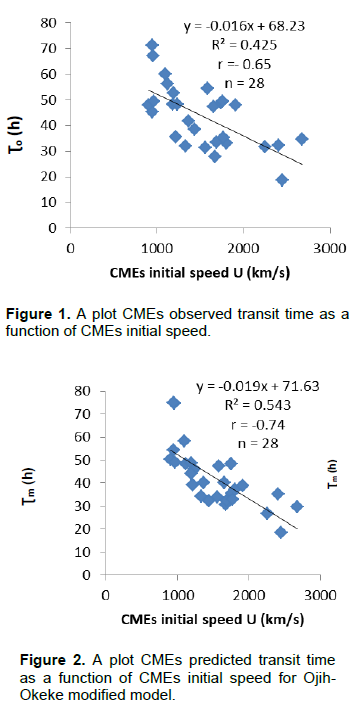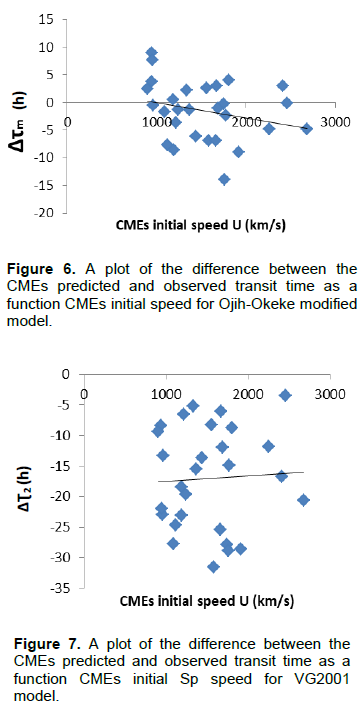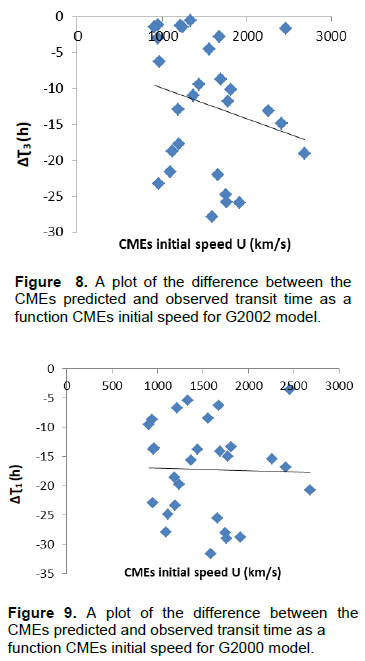ABSTRACT
Predicting the arrival time of Coronal Mass Ejections (CMEs) with a lower value of average error of the difference between the predicted and the observed transit time is very crucial in space weather forecast. A modified Empirical Coronal Mass Ejection Arrival (ECA) model was proposed, namely, Ojih-Okeke modified ECA model to predict the transit time of twenty eight fast CMEs from the sun to the earth. This is the first time the Ojih-Okeke modified ECA model is being applied in prediction of transit time of CMEs from the sun to the earth. The proposed modified model was tested using data obtained from coronagraph observations of large angle spectrometric aboard, the Solar and Heliospheric Observatory (SOHO/LASCO) CME catalogue from the period of 1997 to 2015. To ascertain the accuracy of the modified model, the three ECA model of Gopalswamy (G2000, G2001, and VG2002) were applied to our data points. Linear regression analyses were carried out on the data points and scatter plots were generated using excel software package. The average error of the difference between the CMEs transit time and models predicted transit time with their fractional errors were 4.27 h and 0.10 for the Ojih-Okeke modified model; 10.36 h and 0.23 for the VG2002 model; 12.93 h and 0.29 for G2001 model; and 14.42 h and 0.32 for the G2000 model. The proposed modified model has proved very effective in prediction of arrival time of CMEs. It is our recommendation that future work on prediction of the arrival time of CMEs be carried out employing our modified ECA model.
Key words: Coronal mass ejections, arrival time, intense geomagnetic storm, observed transit time, earth and phase.
Coronal Mass Ejections (CMEs) are released from the sun’s surface into space as massive burst of solar materials consisting of magnetic fields and clouds of plasma. They are the most destructive of all solar events. CMEs may accelerate up to a speed of 3000 kms-1 and gradually propagate through the solar wind, away from the sun (Yashiro et al., 2001). CMEs are known to be the major cause of severe geomagnetic disturbances which is often referred to as space weather (Zhang et al., 2001; Cheng et al., 2014; Cyr et al., 2000; Mishra and Tripathi, 2005). There are several space weather phenomena which tend to be associated with or are caused by geomagnetic storm. These include Solar Energetic Particles (SEP) events which are hazardous to humans, Geomagnetically Induced Current (GIC) which cause damages to satellites and electrical grid, ionospheric disturbances which may lead to radio and radar scintillation, disruption of navigation by magnetic compass. Therefore, predicting the arrival time of CMEs becomes necessary for this will serve as a practical way of getting advance warning of solar disturbances heading towards the earth, save billions of currency that would have been used to repair or replace damaged satellites and electrical grids, identify communication problems, help high altitude flight management and make provisions for renewable energy sources to protect the earth against black out.
Most researchers have predicted the arrival time of CMEs to 1 AU employing different models. Gopalswamy et al. (2001) developed an Empirical Coronal Mass Ejection Arrival (ECA) model to predict the arrival time of CMEs. From their prediction, they discovered that the average error of the difference between the predicted CMEs arrival time and the observed transit time was 11 h. Owens and Cargil (2004) investigated the three ECA models of Gopalswamy known as G2000, G2001 and VG2002 to predict the arrival time of CMEs to the earth using 35 CME – ICME data obtained from Advanced Composition Explorer (ACE) and Solar and Heliospheric Observatory (SOHO) from November 1997 to April 2001 with CME speed at the sun as input parameter. They asserted that the average error of the difference between the CMEs observed transits time and the predicted 1 AU CMEs arrival time was approximately 11 hrs. Further work was carried out in other to obtain a lower value. Therefore Gopalswamy et al. (2005) later developed an Empirical Shock Arrival (ESA) model to predict the arrival time of CMEs. The average error between the predicted CMEs arrival time and the observed transit time was found to be 12 h. Interestingly, the time interval was 12 h, this increment is not encouraging.
Okeke et al. (2011) used the three empirical models of Golpalswamy (G2000, G2001 and VG2002) to predict the arrival time of twenty-nine Halo CMEs. Their result showed that the average error of the difference between the CMEs observed transit time and the predicted transit time were 15, 12 and 10 h, respectively. They concluded that the errors remained significant and suggested that the model should be enhanced. Mostl et al. (2014) used three geometrical models, namely, Self-Similar Expansion Fitting (SSEF), the Fixed Point Fitting (FPF) and Harmonic Mean Fitting (HMF) to predict the arrival time of 22 CMEs. The SSEF fitting technique allows flexibility for the CME width in the solar equatorial plane than the FPF or the HMF (extremely wide). The fixed point fitting model assumes a point like CME without any extension in heliocentric longitude. The self-similar expansion model could be seen as a generalization of the fixed point fitting and harmonic mean fitting. All methods share the same assumption of constantly CME speed and direction but differ on the description of the global shape of the CME front. Their results showed that the average error the difference between the CMEs observed transit time and the predicted arrival time was 10.9 h.
Tong et al. (2015) carried out a statistical study of 21 earth directed CMEs using the Graduated Cylindrical Shell and Drag Force Model. The average error of the difference between the predicted and observed transit time was found to be 12.9 h. This high value of 12.9 h is very alarming and disturbing. Carolina et al. (2017) studied the arrival time of eleven coronal mass ejections using microwave radio emissions as a proxy. Their result showed an average error between the observed and predicted transit time to be 11 h for microwaves and 9 h for soft X-ray (S X R). The results of all the aforementioned findings showed that the average error of the difference between the CMEs observed and the predicted transit time is still large. Predicting the arrival time of CMEs with a minimal average error between the CMEs observed and the predicted transit time has been a major issue in the field of Heliophysics.
The Coronal Mass Ejections data used were procured from Large Angle Spectrometric Coronagraph aboard, the Solar and Heliospheric Observatory (SOHO/LASCO) CME catalog on website (http://cdaw.gsfc.nasa.gov/CMElist/index.html). Only CMEs with initial speed of 900 kms-1 and above (fast CMEs) that were associated with geomagnetic storms with Dst≤-100 nT were selected. The geomagnetic storm data were obtained from World Data Centre for geomagnetism Kyoto Japan. Multiple CMEs were avoided as they may lead to CME-CME interaction which may in turn affect the transit time. The CMEs selected were Halo CMEs, it has been established that Halo CMEs are the most geo-effective having ability to cause geomagnetic storm. In order to ascertain the accuracy of the model, the three ECA model of Gopalswamy were also applied to the data points.
Theory of Ojih-Okeke modified ECA model
The authors assumed that: (1) fast CMEs undergo three phases, as they travel from sun to earth: a deceleration which ceases before 0.1 AU, a constant speed propagation until about 0.45 AU and a gradual deceleration to 1 AU; (2) CMEs travel with solar wind speed from 0.45 to 1AU. The transit time of CMEs from the sun to the earth is given by:
where a2 is an effective interplanetary acceleration that was derived empirically from quadratic observations of CMEs, U is initial speed of CMEs and d is the acceleration cessation distance (0.76 AU).
Theory of Vrsnak and Gopalswamy (2002) model: Aerodynamic drag
The model was proposed for estimating the ICME transit time when the only force acting upon the ICME in interplanetary space is the aerodynamic drag. They assumed that the drag force was linearly proportional to the relative velocity.
The equation of motion of an ICME at some heliocentric distance R (R= where r is heliocentric radius and is solar radius given by:
Equations 1, 2, 3, and 4 were applied to the CMEs data to calculate the predicted arrival time for each model. The difference between the CMEs observed transit time and the model’s predicted transit (∆τ) were calculated. The average error and fractional error of the difference between the CMEs predicted transit and observed transit time for each model was calculated.
The average error between the observed and predicted transit time and fractional errors are shown in Table 1. Scatter plots of CMEs predicted transit time as function of CMEs initial speed were generated for each model.
The model equations were applied to the CMEs data. The difference between the CMEs predicted and observed transit time (∆τ = τmod – τobs) were calculated for each model. The average error between the CMEs observed and the predicted transit time and the fractional error for each model were also calculated. Table 1 shows the summary of the average error and fractional error between the CMEs observed and predicted transit time (∆τ) and fractional error of twenty eight fast coronal mass ejection events associated with intense geomagnetic storm observed from the period of 1997 to 2015. The average error and fractional error of the difference between the CMEs observed and the predicted transit time for Gopalswamy 2000 (G2000) model were 14.42 h and 0.33. This result obtained for the G2000 model is in close agreement with the result of Okeke et al. (2011) who obtained the average error between the CMEs observed and predicted transit time of 14.83 h and fractional error of 0.57.
The average error of the difference between the CMEs observed and the predicted transit time and the fractional
error obtained for Gopalswamy 2001 (G2001) model were 12.93 h and 0.29, respectively. The average error between the CMEs predicted transit time and the observed transit time obtained for the Vrsnak and Gopaswmy, 2002 (VG2002) is 10.36 h while the fractional error is 0.23. The average error between the CMEs predicted and observed transit time obtained for the Ojih-Okeke modified model was 4.27 h with fractional error of 0.10. The error in Ojih-Okeke modified model is likely traceable to geometrical effects. According to Carolina et al. (2017), CMEs is a curved 3-D structure, the measured arrival time depends on which part of CMEs is being sampled and also CMEs become deformed in the interplanetary medium with an elongation taking place in a direction perpendicular to the principal direction of the motion. Figure 1 show a scatter plot of the CMEs observed transit time as a function of CMEs initial speed. The linear correlation coefficient obtained from the scatter plot is -0.65 the negative correlation shows that as speed increases, time decreases. Figures 2, 3, 4 and 5 show the scatter plots of CMEs predicted transit time as function of CMEs initial speed for Ojih –Okeke modified model, VG2002 model G2001 model and G2000 model. The values of the linear correlations coefficients obtained from the scatter plots are -0.74 for the Ojih-Okeke modified model; -0.82 for VG2002 model; -0.81 for the G2001 model and -0.81 for G2000 model. These values of linear correlation coefficients obtained from the four models depict that there exist a strong correlation between CMEs transit time and CMEs initial speed.


Figures 6, 7, 8 and 9 show the scatter plots of the difference between the predicted transit time and the observed transit time (∆τ) as function of CMEs initial speed for Ojih-Okeke modified model, G2001 model, VG2002 model, and G2000 model, respectively. The G2000 model, G2001 model and the VG2002 model predict all the 28 events corresponding to 100% earlier than observed. It is obvious that the G2000, G2001 and VG2002 models underestimate the CMEs transit time as the plots show large negative distribution of ∆τ Hence, the need for the development of a modified model. The modified model predict 18 events out of the 28 events corresponding to 64.29% earlier than observed and 10 events corresponding to 35.71% later than observed. Although there are still some slight deviations between the predicted transit time and the observed transit time as observed from the plots. The cause of these slight deviations was attributed to geometrical effect. Geometrical effects due to two reasons, firstly CME is a curved 3-D structure and the measured arrival time depends on the part of the CME that is being sampled by SOHO coronagraph. Secondly, CME becomes deformed in the interplanetary medium with elongation taking place in a direction perpendicular to the principal direction of the motion.


Some researchers attributed the error in CMEs predicted transit time to projection effects. Owens and Cargil (2004) in their analysis of the cause of error asserted that projection effect has no significant difference between the values obtained with projection effects and when projection was removed.
The Ojih-Okeke modified ECA model was applied to predict the transit time of 28 fast CMEs associated with intense geomagnetic storm (Dst≤-100 nT) obtained from the period of 1997 to 2015. Inferences drawn from our results show that the average error of the difference between the CMEs observed transit time and the modified model’s transit time and fractional error were much lower than those obtained from the earlier models. Comparing the results obtained from the four models, the Ojih-Okeke modified model proved the most accurate model for predicting the arrival time of fast CMEs. This is the first time the modified model is being applied to predict the transit time of CMEs from the sun to the earth. It is therefore recommended that future work on prediction of the arrival time of CMEs be carried out employing Ojih-Okeke modified ECA model.
The authors have not declared any conflict of interests.
REFERENCES
|
Carolina SM, Karl L, Gerard T (2017). Microwave radio emission as a proxy for coronal mass ejection arrival speed in predictions of interplanetary coronal mass ejections at IAU. Space Weather Space Climate J. 7:A2.
Crossref
|
|
|
|
Cheng L, Shen YZ, Bin A, Ye MP, Wang S (2014). Full Halo coronal mass ejections arrival at the earth.
View
|
|
|
|
|
Cyr OC, Raymond JC, Thompson BJ, Gopalswamy NK, Kahler SK, Lara N, claravella A, Romol N, Oneal R (2000). SOHO and Radio observation of CME shock Wave. Geophys. Res. Letters J. 27(10):1439-1442.
Crossref
|
|
|
|
|
Gopalswamy N, Lara A, Lepping RP, Kaiser ML, Berdichevsky D, Cyr OC (2000). Interplanetary acceleration of coronal mass ejections. Geophys. Res. Lett. J. 27:145.
Crossref
|
|
|
|
|
Gopalswamy N, Alejandro L, Russel A H (2001). Predicting the I-AU arrival times of coronal mass ejections. Geophys. Res. J. 106(A12):29, 207-209, 217.
|
|
|
|
|
Gopalswamy N, Alejandro L, Yashiro S, Kaiser ML, Howard RA (2005). An empirical model to predict the 1-AU arrival of interplanetary shocks. Adv. space res. J. 36(12):2289-2294.
|
|
|
|
|
Mishra AP, Tripathi RM (2005). Characteristics features of CMEs with respect to their source region. Proceeding of the 29th International Cosmic Ray Conference, Pune, India 1:149.
|
|
|
|
|
Mostl CK, Amla JR, Hall PC, Liewer EM, Jong RC, Colaninno AM, Galvin AB (2014). Connecting speeds , directions and arrival time of 22 Coronal Mass Ejection from the Sun to 1AU. Astrophysi. J. V5/2/11.
Crossref
|
|
|
|
|
Okeke FN, Okpala KC, Akaogu V (2011). Predictions of the arrival time of Coronal Mass Ejection (CME) and its contributions to major Geomagnetic storms. Nig. J. Space Res. 10:217-230.
|
|
|
|
|
Owens M, Cargil P (2004). Predictions of the arrival time of Coronal Mass Ejection at IAU: an analysis of the causes of errors.
|
|
|
|
|
Sheeley NR, Wang YM, Hawley SH, Bruckner GE, Dere, KP, Howard RA, Koomen MJ, Korendyke CM, Michels DJ, Paswaters SE, Socker DG, St. Cyr OC, Wang D, Lamy PL, Liberia A, Schwenn R, Simnett GH, Plunkett S Biesecker DA (1997). Measurements of the flow speed in the corona between 2 and 30 rs. Astrophys. J. 484:472.
Crossref
|
|
|
|
|
Tong S, Yikang W, Linfeng W, Xin C, Mingde D, Jie Z (2015). Predicting the arrival time of coronal mass ejection with the graduated cylindrical shell and drag force model. Astrophys. Res. letters J. 806:2.
|
|
|
|
|
Vrsnak B, Gopalswamy N (2002). Influence of aerodynamic drag on the motion interplanetary ejecta. J. Geophys. Res. 107:10.1029/2001/JA 000120.
|
|
|
|
|
Yashiro SN, Gopalswamy GM, Cyr OC, Plunkett SP, Rich NB, Howard RA (2001). A catalog of white light coronal mass ejections observed by the SOHO Spacecraft. J. Geophys. Res. 109(A):7105.
|
|
|
|
|
Zhang J, Wang T, Zhang C, Liu Y, Nitta N, Slater GL, Wang J (2001). Flare-CME events association with a super activeregion recent insight into the Physics of the Sun and heliosphere: Highlights from SOHO and other space missions. Pal Brekke (Eds), Proceedings of IAU Symposium. P 203.
|
|






